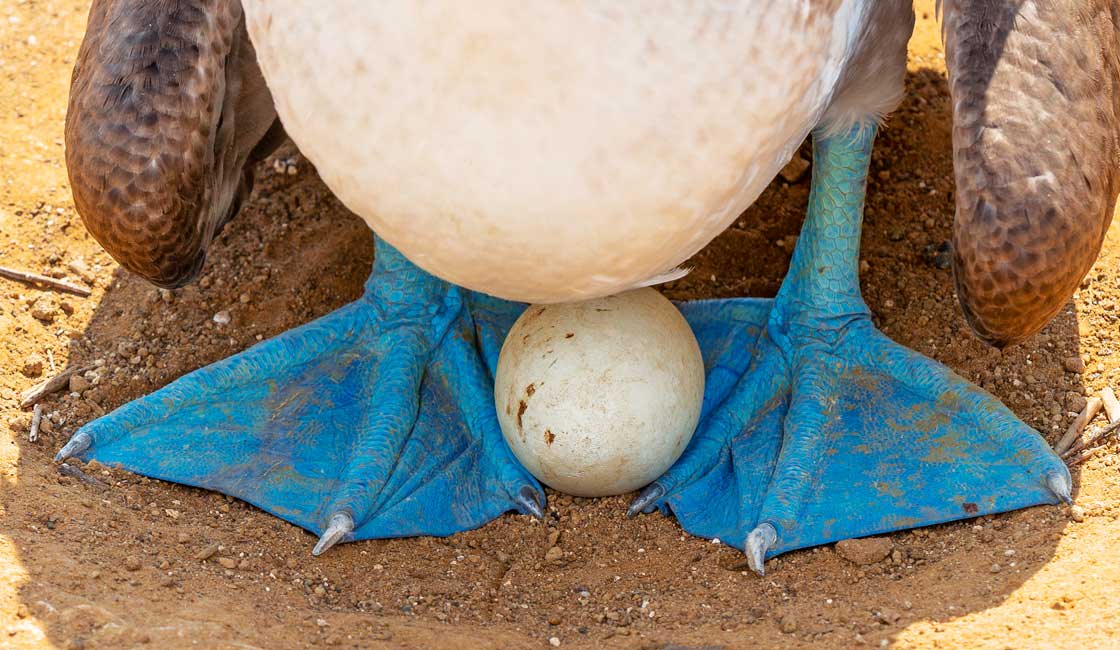Macaw Fun Facts Blue Footed Booby Fun Facts
The Galapagos Islands are home to so many unique and fascinating wildlife species, and amongst the most famous are the blue-footed boobies. These charismatic birds are sure to catch your eye, and not just because of their striking bright blue feet. Read on to learn a host of interesting facts about this intriguing creature.
Blue-footed boobies (sula nebouxii) are one of six species of boobies that belongs to the order Pelecaniformes (pelicans and their relatives). Other boobies include the red-footed booby, masked booby, brown booby, Nazca booby and Peruvian booby, but the blue-footed type is the most common in the Galapagos. Apart from their large blue webbed feet, they are characterized by a long neck, sharp narrow bill and pale brown wings that span about five feet. The bird's facial skin has a bluish tinge, its chest and undersides are white, whilst the rest of its body are covered in shaggy brown and white feathers. Females are larger than males and can also be identified by a dark ring of pigment around the pupil, whilst males are distinguished by their pleasant whistle.

Blue-footed boobies
Galapagos Blue-Footed Booby Facts
1. The Galapagos are home to the World's largest concentration of Blue-Footed Boobies
There are an estimated 40,000 breeding pairs of blue-footed boobies in the world. They are native to Central and South America and can be found all along the Pacific coast, stretching from Southern California down to Peru. This marine bird mainly resides in the open sea but depends on ocean islands for breeding. Approximately 70% of the total blue-footed booby population are found in the Galapagos Islands, so you're virtually guaranteed to spot some on the Galapagos tour.

Preying
2. Blue-Footed Boobies are far better at swimming and flying than walking
Blue-footed boobies often appear rather comical and are notoriously clumsy-looking on land. In fact, the name "booby" derives from the Spanish term bobo meaning "stupid", "foolish" or "dummy". It's thought that their clownish waddling on land, coupled with their apparent fearlessness of humans (which made them easy to capture for food), are what led early Spanish explorers to come up with this name. However, their awkwardness on land is compensated by their agility in the air and water where they spend the majority of their time.

Dive
3. Blue-Footed Boobies are impressive divers
Their diet consists of fish, mainly sardines, anchovies and mackerel, which they catch through a spectacular dive into the water from the air. They are a social species and can often be found in flocks of up to 200 scouring the water for fish with their excellent binocular-style vision. When the booby has spotted its prey it will plunge headfirst into the ocean from heights of up to 80 feet, honing in on its target with great force, speed and precision. They tilt downward at a near-vertical angle, hold their wings back against their streamlined body and also have air sacks in their skulls to protect against the impact. Boobies also dive from sitting position on the water's surface and can also be seen feeding on flying fish which they can catch mid-air.
4. Blue-Footed Boobies make excellent swimmers
With their cigar-shaped body, narrow wings, and long pointed tail, these birds are remarkably agile in the water. The blue-footed species is especially well-adapted to the underwater world. Its swiftness means it can plunge into less than 2 feet of water, pulling out of a dive at remarkable speeds. They also have permanently closed nostrils and breathe through the corners of their mouth when above water.

Mating
5. Blue-Footed Boobies display comical and elaborate mating rituals
Males produce a distinctive courtship display to attract females, consisting of high stepping, strutting and stamping as a way to flaunt his blue feet. This fancy footwork is combined with plenty of "sky pointing" (raising his bill up into the air), bopping around and high-pitched whistling. If the female is sufficiently impressed, she may join in with the dance ritual and touch him with her bill. Witnessing a blue-footed booby mating ritual is a definite highlight of any Galapagos trip, and can be experienced on Daphne, Española, San Cristobal and Isabela Islands.

Expecting
6. There's a logic behind the blue feet
Scientists have discovered that the blue color of the booby's feet is the result of carotenoid pigments obtained from its fish diet. These carotenoids have an antioxidant effect and are thought to stimulate the bird's immune function. The blue pigmentation is, therefore, a reliable indication of the bird's overall health, namely its immunological state and level of nourishment. This is a good explanation for why females are attracted by the blue coloration. In fact, it's highly likely that the female's preference for blue feet has evolved the species to its current state of especially bright blue feet!

Youngster
7. The Blue-footed booby's distinctive feet also come in handy for raising their young
The only time the Blue-footed booby comes ashore is to breed. The female lays one to three eggs at a time and great care is taken to raise the chicks, with both parents taking turns to feed and protect their offspring. Boobies don't construct traditional nests, instead of laying their eggs on bare ground. However, they do surround their nesting area in a ring of excrement to mark out their territory to others. Unlike most birds, boobies do not have a brooding patch (bare skin on their underbelly) to keep their eggs warm. Instead, they use their large webbed feet, which have an increased blood supply for up to a month after hatching, to ensure their young are kept well insulated.
Source: https://www.rainforestcruises.com/guides/blue-footed-booby-facts
0 Response to "Macaw Fun Facts Blue Footed Booby Fun Facts"
Post a Comment